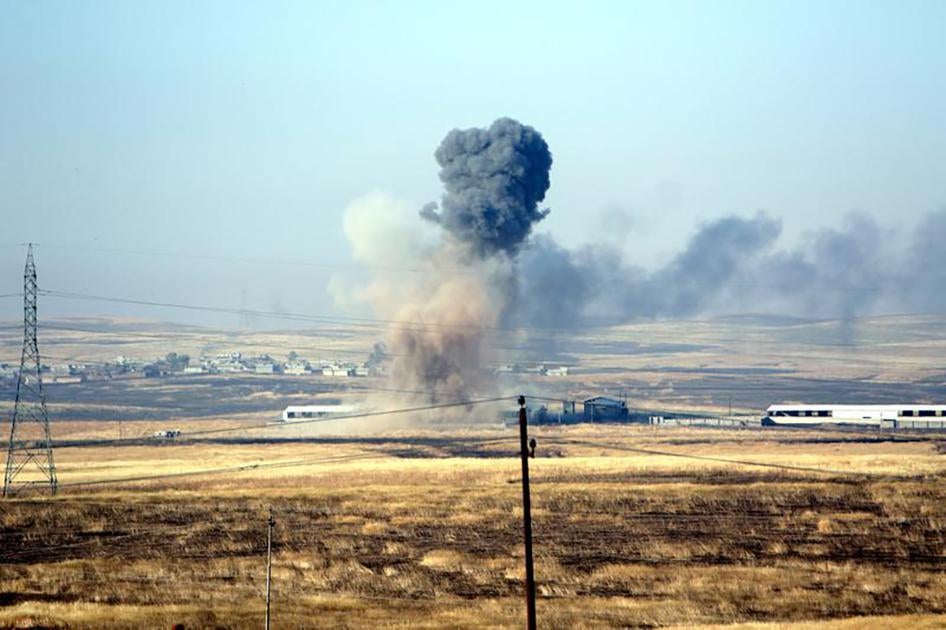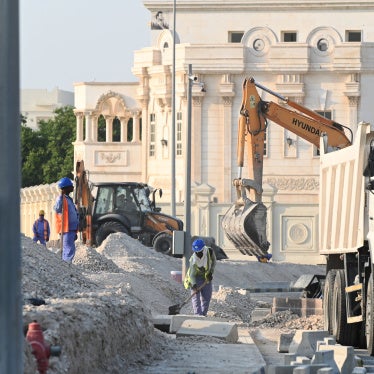(Beirut) – An airstrike targeting Islamic State, also known as ISIS, fighters hit a clinic south of Mosul on October 18, 2016, Human Rights Watch said today. The attack destroyed half the clinic, killed eight civilians, and wounded at least two more.
Two ISIS fighters and the ISIS transport minister were also killed, a witness told Human Rights Watch. A healthcare worker said ISIS fighters had forcibly taken over an office at the clinic and were holding meetings there regularly, putting civilians at risk of attack.
“ISIS fighters’ despicable positioning inside a protected health facility south of Mosul put civilians, including patients, at risk and needs to stop immediately,” said Lama Fakih, deputy Middle East director at Human Rights Watch. “Forces attacking ISIS should take all necessary measures to minimize harm to civilians, including those that ISIS forces may have placed at risk.”
Despite the presence of ISIS fighters, to be lawful, those conducting the airstrike would need to have ensured that they targeted military targets only. They also would have been required to issue an effective warning, to take feasible precautions to protect civilians, and to ensure that the result did not disproportionately harm civilians and civilian objects. United States-led coalition and Iraqi forces should conduct an impartial, thorough, and transparent investigation into the incident to establish who was responsible and whether it was lawful and to compensate victims if it was not, Human Rights Watch said.
On October 17, the Iraqi central government and Kurdistan Regional Government authorities, with the support of an international coalition, began military operations to retake Mosul, and surrounding areas.
On October 18, without warning, an airstrike hit the local clinic in the town of Hammam al-Alil, 30 kilometers southeast of Mosul, which was under ISIS control, according to a United Nations Office for the Coordination of Humanitarian Affairs official, three healthcare workers, and a local official. The healthcare workers said that the attack, at about 9:30 a.m., killed at least eight civilians, including five children, and wounded at least two more. Both the US-led coalition and the Iraqi military are conducting airstrikes in the battle against ISIS. Human Rights Watch was unable to identify the source of the attack.
The clinic, established in 2005, is the main healthcare facility in the area, serving about 70,000 civilians in the town and neighboring villages. The single-story building had 15 rooms that included maternity, x-ray ward, vaccination wards, a dental unit, and a laboratory. Because of the damage from the attack, the clinic has had to move to another building.
One healthcare worker said that in July 2014, when ISIS took control of the town, fighters came to the clinic and told him to move his office, off one of the treatment wards, to another room about 15 meters away. The fighters set up an office in his previous office, frequently meeting there. On October 18, according to the three healthcare workers, an airstrike hit the room ISIS was using.
An ambulance driver at the clinic said that he saw the bodies of three ISIS fighters killed in the attack, including the ISIS transport minister, who also appeared to be a fighter. The ambulance driver saw one high-level ISIS commander leave the building 15 minutes before the strike but the driver brought his body back to the clinic from the neighboring village of al-Shura after an airstrike killed him there the next day.
One healthcare worker said that at the time of the strike, the clinic had about 50 patients. He was in his office when a blast threw him to the ground. The room fell dark and he could feel dust in the air. It took him about two minutes before he was able to get up and walk out.
“When I got out I saw that the left wing of the clinic, only about 15 meters from my office, was completely destroyed,” he said. “I started walking without knowing where to go, but suddenly found myself in the neighborhood mosque. I saw at least two dead bodies as I walked. After 10 minutes in the mosque I turned back to the clinic, but saw that more ISIS fighters had arrived at the clinic and were firing bullets in the air so I left.”
Among the dead was a 72-year-old man and his two grandsons, aged 6 and 7, whom he had taken to the hospital for polio vaccinations, healthcare workers said. In the same ward, they said, a nurse was killed and another was wounded, with a metal fragment to her shoulder. Three more children were killed in the treatment ward adjacent to the ISIS office. A young man who ran a small convenience store at the entrance of the clinic was also killed. The clinic’s pharmacist’s leg was broken.
The healthcare workers said that more than half of the clinic was destroyed, including the x-ray department, vaccination division, and human resources and administrative departments.
Under the laws of war applicable to the armed conflict in Iraq, hospitals and other medical facilities receive special protection. Medical facilities remain protected from attack unless they are used to commit acts “harmful to the enemy” outside their humanitarian function. Such acts do not include medical treatment of enemy fighters, which all medical personnel should be able to provide without fear of being targeted in an attack. Even when medical facilities are used for acts harmful to the enemy, they are only subject to attack after a warning has been given setting a reasonable time limit and after the warning has gone unheeded. Armed forces or groups should not occupy medical facilities.
All forces in the conflict, including those engaged in bombing, are obligated under the laws of war to take all feasible precautions to minimize harm to civilians. Attacks that are indiscriminate because they fail to distinguish between combatants and civilians are prohibited, as are attacks that are disproportionate because the anticipated civilian harm is excessive compared with the expected military gain.
This is not the first time ISIS fighters have positioned themselves inside medical facilities in Iraq. ISIS fighters had been occupying the second floor of Fallujah General Hospital for several months before an airstrike hit the hospital at 8 p.m. on May 25, without warning. The attack damaged the emergency room and other parts of the facility. Local doctors told Human Rights Watch that ISIS also has offices in clinics in Qayyarah, 60 kilometers south of Mosul, and Jadah, 65 kilometers south of Mosul, when they controlled those towns. A senior healthcare worker at the Hammam al-Alil clinic told Human Rights Watch that doctors at various Mosul facilities told him that ISIS has offices in all the facilities they work in – the Republican, Ibn Sina, al-Salam, and Mosul General Hospitals.
All parties to the conflict should ensure that medical facilities are protected from attacks or interference by third parties and take meaningful steps to prevent the military occupation of hospitals.
Under international human rights law, attacks on health facilities, workers, or transport vehicles may impede the right of access to health care and the right to the highest attainable standard of health. In December 2014, the United Nations General Assembly passed a landmark resolution urging member countries to take immediate steps to ensure that health workers everywhere are protected from violence.
“ISIS’s repeated use of hospitals for military purposes in Mosul and elsewhere in Iraq is a cynical and unlawful act that means coalition and Iraqi forces need to ensure heightened care in their attacks,” Fakih said.









